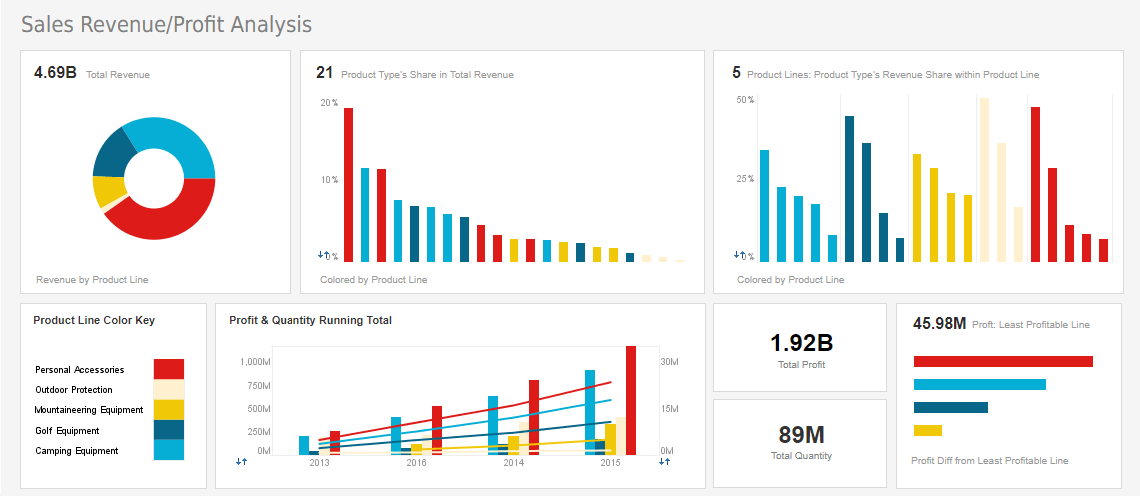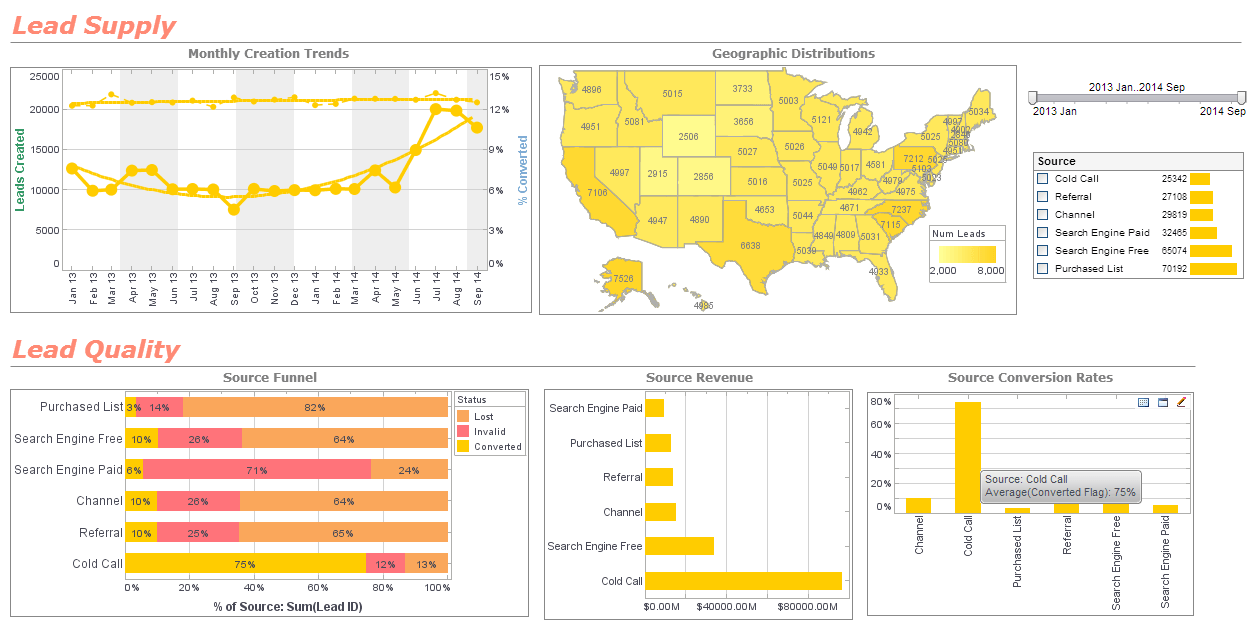Looking for a Free Visual Analysis Tool?
Are you looking for an application that can track and display information through point-and-click, easy to understand visual analyses, without spending big? Are you trying to organize and report your company's information in the form of dashboards and scorecards? Are you looking for ways to easily integrate company information from multiple data sources, for more in depth business analysis? If so, InetSoft's free application may be just the solution you're seeking.
InetSoft's free application is an easy to use version of InetSoft's leading-edge commercial data visualization application. Designed for business users, it is perfect for individual analysts or departmental workgroups, allowing users to quickly share business information and insights with team members. The simple, intuitive interface ensures that you do not have to be a tech or IT professional to be able to create impactful and meaningful dashboards for your business.
Comparing InetSoft’s Free Visual Analysis Tool to Other Popular Options
When organizations evaluate data visualization tools, the market can feel saturated with options promising flexibility, scalability, and ease of use. Among the many contenders, InetSoft’s free visual analysis tool stands out for its combination of enterprise-grade features and a cost-free entry point. However, it is best understood when compared with other well-known players such as Tableau Public, Microsoft Power BI (free edition), and Google Data Studio. Each tool has unique strengths and limitations, and IT leaders often want to see a side-by-side exploration of how they stack up in terms of deployment, licensing, resource requirements, overhead, support, and end-user satisfaction.
Licensing and Cost Structures
Cost is one of the most immediate differentiators between InetSoft’s offering and the alternatives. InetSoft’s free visual analysis tool is part of a broader product ecosystem, providing an entry point that does not lock users into restricted trial periods or aggressive upgrade paths. In contrast, Tableau Public is free but requires that all workbooks and dashboards be saved to the public cloud, which raises data confidentiality concerns. Microsoft Power BI’s free version is tied to limited cloud storage and restricted sharing capabilities, often nudging organizations toward paid Pro or Premium licenses once collaboration needs increase. Google Data Studio is entirely free, but it functions primarily as a web-based dashboarding layer, not a complete analysis suite. Compared side by side, InetSoft provides a balance of enterprise-grade capability without forcing teams into immediate spending decisions.
Deployment Flexibility
InetSoft’s tool is built around serverless microservices architecture, giving IT teams flexible deployment models. It can run as a containerized service in private cloud, public cloud, or hybrid setups. This is particularly appealing for organizations that must comply with strict governance or prefer to avoid vendor lock-in. Tableau Public, by comparison, is cloud-only and offers no control over hosting. Microsoft Power BI free edition is also tied tightly to the Microsoft ecosystem, favoring Azure and Office 365 integrations, which can be a limitation for organizations running multi-cloud strategies. Google Data Studio similarly exists only in the cloud, requiring data sources to be accessible via Google connectors. In terms of deployment freedom, InetSoft clearly gives IT departments more control over where and how visual analysis runs.
Data Connectivity and Integration
Data connectivity is another area where differences emerge. InetSoft supports a broad array of connectors for databases, APIs, spreadsheets, and warehouses, allowing teams to unify on-premises and cloud data. More importantly, its data mashup capabilities let analysts blend sources without building complex ETL pipelines. Tableau Public connects to many sources but often requires desktop-level installations to build complex integrations, and publishing them comes with the public exposure caveat. Microsoft Power BI free supports fewer live connections compared to its Pro version, limiting enterprise-scale integration in free mode. Google Data Studio has solid integrations with Google’s ecosystem—Google Analytics, BigQuery, and Sheets—but outside of that, it often depends on third-party connectors that introduce costs or technical friction. InetSoft’s ability to unify data from disparate systems without requiring additional middleware is one of its strongest selling points.
User Experience and Learning Curve
Ease of use is a key factor in adoption. InetSoft’s free tool employs a drag-and-drop interface that empowers business users to create dashboards and visualizations without coding knowledge. It is intuitive enough for non-technical staff yet provides deeper customization options for power users and IT teams. Tableau Public is often praised for its rich visualization library and storytelling capabilities, but it can overwhelm new users who are unfamiliar with BI tools. Microsoft Power BI’s free edition benefits from tight integration with Excel, which lowers the barrier for spreadsheet-savvy professionals, though its more advanced modeling features can feel rigid. Google Data Studio wins points for its simplicity but lacks the analytical depth that organizations often need for more complex scenarios. Overall, InetSoft’s design philosophy seems to strike a middle ground: advanced capability with low entry friction.
Performance and Scalability
Scalability is where many free tools falter. InetSoft’s microservice design means that teams can scale horizontally by adding more instances as workloads increase, even during the free evaluation. Performance tuning, caching, and incremental refresh features are built in, making the tool suitable for larger datasets and more demanding concurrency. Tableau Public, on the other hand, is not built for enterprise scalability—it is intended primarily for sharing individual projects with the community. Microsoft Power BI free has better scalability within the Microsoft ecosystem but requires a Pro upgrade for meaningful collaboration and larger datasets. Google Data Studio struggles with very large datasets, especially when live connections are slow or external connectors are used. InetSoft’s ability to scale under enterprise conditions without immediately hitting license walls is a notable differentiator.
Overhead and Resource Requirements
Resource overhead is often overlooked until IT teams hit constraints. InetSoft’s architecture minimizes overhead by leveraging lightweight container deployment, allowing quick setup and controlled resource usage. This is particularly advantageous for IT teams that want to test the solution in parallel with existing platforms without heavy provisioning. Tableau Public has minimal overhead because it is cloud-based, but that comes at the cost of zero governance control. Microsoft Power BI’s free edition requires users to manage integration with Azure and Office 365, which may add to overhead in organizations not already standardized on those services. Google Data Studio has the lowest technical overhead, being purely cloud-based, but it introduces limitations in reliability and flexibility. For IT managers concerned with cost-to-maintain ratios, InetSoft balances efficiency and control.
Support and Community
Support is another factor that differentiates InetSoft. Even with its free tool, InetSoft provides documentation, tutorials, and a structured evaluation program with access to solution engineers. This is in stark contrast to Tableau Public, which primarily relies on community forums, or Google Data Studio, which offers help articles but little personalized support. Microsoft Power BI free offers solid documentation and community forums, but enterprise-level support is tied to paid tiers. InetSoft’s willingness to invest in support, even for free-tier users, demonstrates a long-term strategy of lowering the adoption barrier and building confidence before customers scale up.
End-User and Management Satisfaction
From a management perspective, free tools are often judged on whether they provide credible pathways to enterprise adoption. InetSoft wins in this regard because the free visual analysis tool is essentially a production-grade system offered at no cost for evaluation. Executives appreciate that the time spent building dashboards and pipelines during the free phase is not wasted—those assets carry forward seamlessly into a paid production deployment. With Tableau Public, work is not portable into secure environments without rework. Power BI free projects usually require upgrading to Pro licenses for production, which means reconfiguring sharing and permissions. Google Data Studio dashboards can be carried into enterprise settings but rarely meet the full analytical needs of large organizations. For managers and end users alike, InetSoft’s evaluation process feels less like a toy and more like an authentic starting point.
Try InetSoft's Free Visual Analysis Tool
When comparing free tools, one must look beyond flashy visualizations and ask: Does this path scale with us? Tableau Public is best for public-facing data storytelling. Power BI free is great for teams already entrenched in Microsoft ecosystems. Google Data Studio shines for lightweight dashboarding, especially in marketing analytics. But InetSoft’s free visual analysis tool positions itself differently—it is not a stripped-down version but a scalable, production-ready platform designed for serious testing. That distinction matters to IT professionals who know that the hardest part of adopting new software is not the first dashboard, but the migration path when demands grow. InetSoft seems to solve that puzzle more elegantly than its peers.


About InetSoft's Commercial Version
InetSoft's free application is a great way to get started in visual analytics. The easy to use interface gives you the tools that you need to understand your business better and move forward in making the right business decisions. If you really love what you get from the free version, you can easily upgrade for more users with the Growth Account option, or you can ask to evaluate the enterprise edition of StyleBI. No on-staff BI developer is required. InetSoft offers free assistance during your evaluation and through the life your license.
By upgrading to the Growth Account option, you'll gain access to unlimited usage, as well as greater data source connectivity. Advanced customization options, flexibility, and IT-friendliness, along with access to a wider array of enterprise data source types make InetSoft an attractive option for your organization's BI needs.

